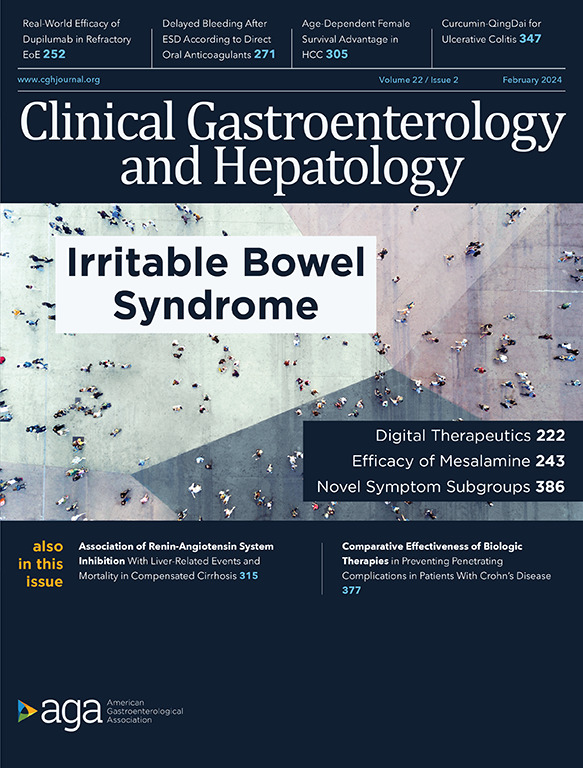Decreasing Case Fatality Rates for Patients With Cirrhosis Infected With SARS-CoV-2: A National COVID Cohort Collaborative Study
IF 12
1区 医学
Q1 GASTROENTEROLOGY & HEPATOLOGY
引用次数: 0
Abstract
Background & Aims
The virulence and severity of SARS-CoV-2 infections have decreased over time in the general population due to vaccinations and improved antiviral treatments. Whether a similar trend has occurred in patients with cirrhosis is unclear. We used the National COVID Cohort Collaborative (N3C) to describe the outcomes over time.
Methods
We utilized the N3C level 3 data set with uncensored dates to identify all patients with chronic liver disease (CLD) with and without cirrhosis who had SARS-CoV-2 infection as of November 2023. We described the observed 30-day case fatality rate (CFR) by month of infection. We used adjusted survival analyses to calculate relative hazard of death by month of infection compared with infection at the onset of the COVID-19 pandemic.
Results
We identified 117,811 total patients with CLD infected with SARS-CoV-2 between March 2020 and November 2023: 27,428 (23%) with cirrhosis and 90,383 (77%) without cirrhosis. The observed 30-day CFRs during the entire study period were 1.1% (1016) for patients with CLD without cirrhosis and 6.3% (1732) with cirrhosis. Observed 30-day CFRs by month of infection varied throughout the pandemic and showed a sustained downward trend since 2022. Compared with infection in Quarter 2 of 2020 (at the beginning of the pandemic), the adjusted hazards of death at 30 days for infection in Quarter 3 of 2023 were 0.20 (95% confidence interval [CI], 0.08–0.50) for patients with CLD without cirrhosis and 0.35 (95% CI, 0.18–0.69) for patients with CLD with cirrhosis.
Conclusions
In this N3C study, we found that the observed 30-day CFR decreased progressively for patients with CLD both with and without cirrhosis, consistent with broader trends seen in the general population.
降低感染 SARS-CoV-2 的肝硬化患者的病死率:一项全国 COVID 队列合作研究。
背景:由于疫苗接种和抗病毒治疗的改进,SARS-CoV-2 感染的毒力和严重程度在普通人群中逐渐降低。肝硬化患者是否也有类似趋势尚不清楚。我们利用国家 COVID 队列协作组织(N3C)来描述随着时间推移的结果:我们利用 N3C 第 3 级数据集的非剪切日期,确定了截至 2023 年 11 月感染 SARS-CoV-2 的所有慢性肝病 (CLD) 患者,包括肝硬化患者和非肝硬化患者。我们按感染月份描述了观察到的 30 天病死率 (CFR)。我们使用调整后的生存分析来计算感染月份与 COVID-19 大流行开始时的感染相比的相对死亡风险:在 2020 年 3 月至 2023 年 11 月期间,我们共发现了 117811 名感染 SARS-CoV-2 的慢性阻塞性肺病患者,其中 27428 人(23%)患有肝硬化,90383 人(77%)未患肝硬化。在整个研究期间,未患肝硬化的 CLD 患者的观察 30 天 CFR 为 1.1%(1,016 例),患肝硬化的患者为 6.3%(1,732 例)。按感染月份分列的观察到的 30 天 CFR 在整个大流行期间各不相同,自 2022 年以来呈持续下降趋势。与 2020 年第 2 季度(大流行开始时)的感染相比,2023 年第 3 季度感染的非肝硬化慢性阻塞性肺病患者 30 天死亡的调整后危险度为 0.20(95%CI 0.08-0.50),肝硬化慢性阻塞性肺病患者为 0.35(95%CI 0.18-0.69):在这项 N3C 研究中,我们发现有肝硬化和无肝硬化的慢性阻塞性肺病患者观察到的 30 天 CFR 都在逐渐下降,这与一般人群中的广泛趋势一致。
本文章由计算机程序翻译,如有差异,请以英文原文为准。
求助全文
约1分钟内获得全文
求助全文
来源期刊
CiteScore
16.90
自引率
4.80%
发文量
903
审稿时长
22 days
期刊介绍:
Clinical Gastroenterology and Hepatology (CGH) is dedicated to offering readers a comprehensive exploration of themes in clinical gastroenterology and hepatology. Encompassing diagnostic, endoscopic, interventional, and therapeutic advances, the journal covers areas such as cancer, inflammatory diseases, functional gastrointestinal disorders, nutrition, absorption, and secretion.
As a peer-reviewed publication, CGH features original articles and scholarly reviews, ensuring immediate relevance to the practice of gastroenterology and hepatology. Beyond peer-reviewed content, the journal includes invited key reviews and articles on endoscopy/practice-based technology, health-care policy, and practice management. Multimedia elements, including images, video abstracts, and podcasts, enhance the reader's experience. CGH remains actively engaged with its audience through updates and commentary shared via platforms such as Facebook and Twitter.

 求助内容:
求助内容: 应助结果提醒方式:
应助结果提醒方式:


